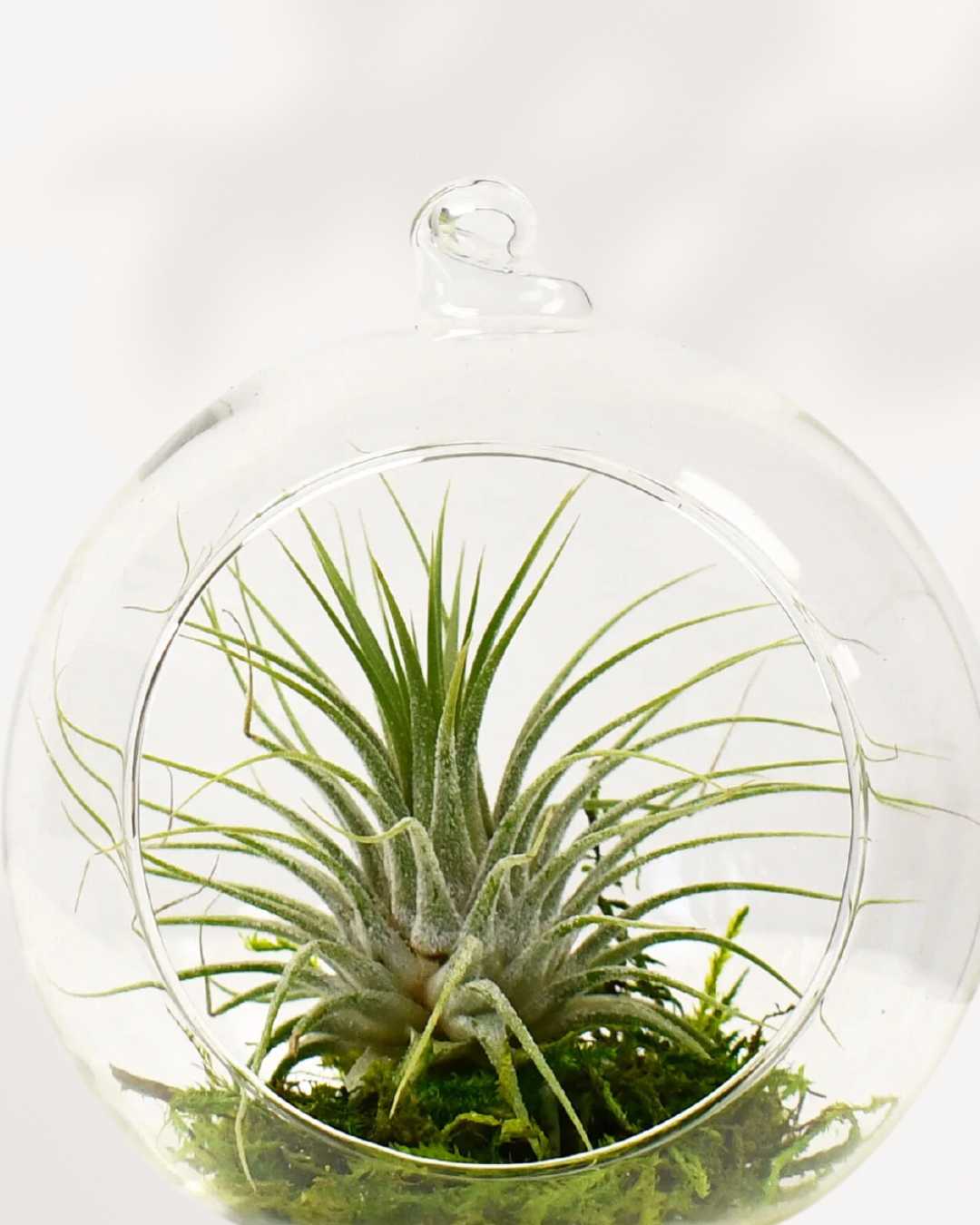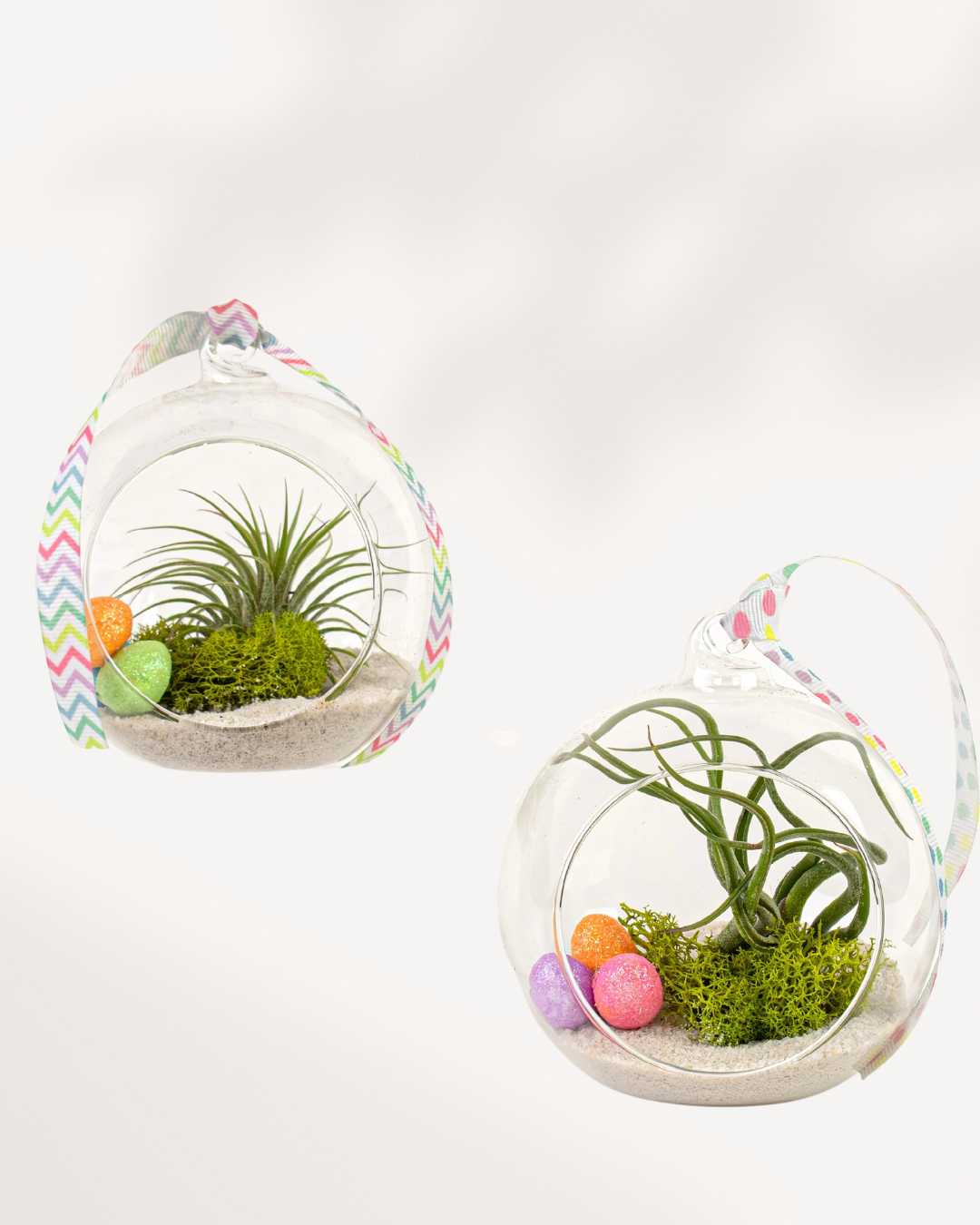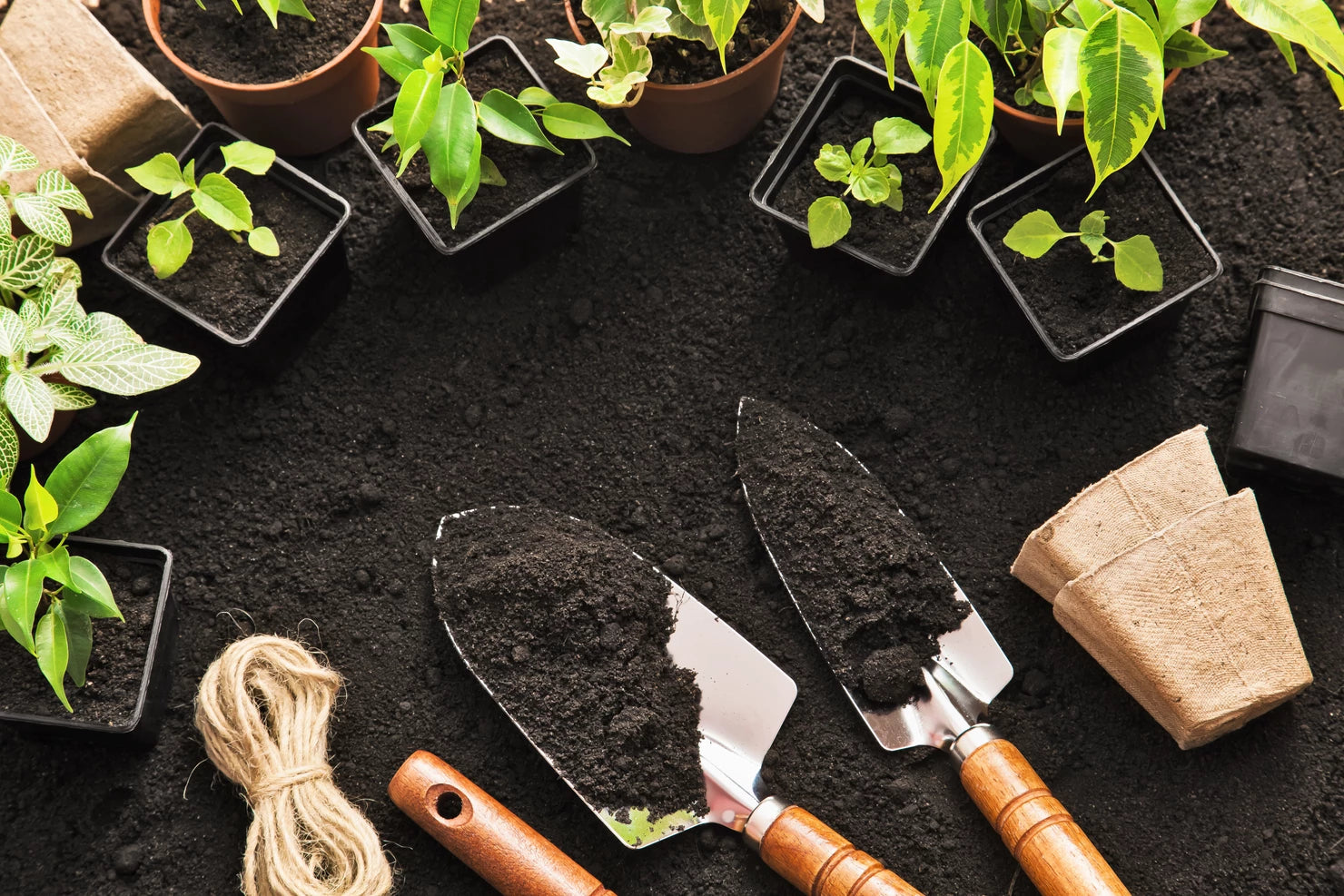Couldn't load pickup availability
Air Plant Terrarium is a unique and decorative way to showcase Tillandsia plants. These low-maintenance, soil-free plants thrive in glass containers, adding a modern and elegant touch to any space. Perfect for desks, shelves, and tabletops, Air Plant Terrariums are versatile and easy to care for.
Common Names
- Air Plant Terrarium
- Glass Plant Display
- Hanging Terrarium
Botanical Classification
- Kingdom: Plantae
- Order: Poales
- Family: Bromeliaceae
- Genus: Tillandsia
- Species: Multiple Tillandsia species
Native Habitat
Air Plants (Tillandsia) are native to tropical and subtropical regions of Central and South America. They thrive in humid environments, often attaching themselves to trees, rocks, and other surfaces without the need for soil.
Historical and Cultural Significance
Air Plant Terrariums have become a symbol of modern, minimalist décor. Their ability to grow without soil makes them popular for creative arrangements and eco-friendly displays. Historically, Tillandsia plants were used for medicinal and decorative purposes in various cultures.
Uses and Popularity
Air Plant Terrariums are ideal for home décor, gifts, and event decorations. Their low-maintenance nature and aesthetic appeal make them a favorite among plant enthusiasts and interior designers.
Conservation Status
Air Plants are widely cultivated and not considered endangered. They are readily available in nurseries and online stores.
Description
Physical Characteristics
Air Plants are known for their spiky, rosette-shaped leaves that come in various sizes and colors, ranging from green to silver. When placed in glass terrariums, their unique forms are highlighted, creating visually stunning displays.
Growth Habit
Air Plants grow without soil by absorbing moisture and nutrients through their leaves. They can be placed in open or closed terrariums, hanging globes, or mounted on driftwood for creative arrangements.
Popular Air Plant Varieties
Tillandsia Xerographica
- Large, curly leaves with a striking appearance.
Tillandsia Juncea
- Tall, slender leaves perfect for vertical arrangements.
Tillandsia Ionantha
- Compact, vibrant leaves that turn red during blooming.
Tillandsia Bulbosa
- Curly, bulbous leaves that create an exotic look.
Tillandsia Caput Medusae
- Snake-like leaves that resemble Medusa's hair.
Care Guide
Light Requirements
Air Plant Terrariums require bright, indirect light. Place them near windows or under artificial grow lights for optimal growth. Avoid direct sunlight, which can cause leaf damage. Learn More
Watering Needs
Mist the plants 2-3 times a week or soak them in water for 20-30 minutes every 1-2 weeks. Allow them to dry completely before placing them back in the terrarium. Indoor Plant Watering
Air Circulation
Ensure proper ventilation around the plants, as stagnant air can lead to rot. Open terrariums are ideal for maintaining airflow.
Fertilization
Feed with a diluted, bromeliad-friendly fertilizer once a month during the growing season for healthy growth.
Common Pests
Aphids
Aphids can gather on leaves, feeding on sap. Treat infestations with neem oil or insecticidal soap. Learn More
Mealybugs
Mealybugs leave white, cotton-like clusters on leaves. Remove them using rubbing alcohol or insecticidal soap. Learn More
FAQs
Do Air Plant Terrariums need soil?
No, Air Plants do not require soil. They absorb nutrients and moisture through their leaves.
How often should I water Air Plants?
Mist them 2-3 times per week or soak them for 20-30 minutes every 1-2 weeks.
Are Air Plants safe for pets?
Yes, Air Plants are non-toxic to pets, making them a safe addition to pet-friendly homes.
Can I keep Air Plant Terrariums in low light?
They prefer bright, indirect light. Low light can slow their growth, so supplement with grow lights if necessary.
How to take care of Air Plant Terrarium
Sun: Indirect
Sun: Indirect
Light: Bright
Light: Bright
Water: Every Week
Water: Every Week
Humidity: High
Humidity: High
Pet Friendly: Yes
Pet Friendly: Yes
Pro Tip
Pro Tip
Delivery Policy for Plant Condition
Delivery Policy for Plant Condition
"I have only received part of my order. What to do?
No worries if you've only got part of your order! Our plants come from different nurseries and might arrive in separate shipments, typically 1-2 days apart. It's all part of ensuring your green friends reach you in top-notch condition!
If you do not receive the remaining packages within 48 hours contact support at info@mygreenscape.ca
What is the Life Time Support?
Absolutely! Lifetime support means you can count on us whenever you have questions or uncertainties about your plant. Whether you're puzzled by its behavior or just want to ensure it's thriving, we're here for you. Connect with us on Instagram @mygreenscapeto or shoot us an email at support@mygreenscape.ca.
When it comes to our guarantee for plants shipped with standard or express, rest assured that we offer a 30-day happy healthy plant guarantee on all such shipments. This ensures that your plants are covered for 30 days after delivery, giving you peace of mind regarding their condition. If you have any concerns within this period, feel free to reach out to us for assistance.
For further details, please visit our Local Delivery, Store Pickup, Standard Shipping Guide Page.
What to expect
What to expect
Your plant will arrive in a standard nursery pot, typically 0.5" - 1" smaller than the stated size to seamlessly fit into your chosen decorative pot. Washable Paper Planter Bags are available for separate purchase.
Just like nature intended, each plant is unique, showcasing natural variations in size, shape, and characteristics. Our commitment is to deliver a plant that closely resembles the one featured on our website, matching your chosen size, and with the potential to thrive happily in your home.
Frequently Asked Questions
Frequently Asked Questions
Certainly! If you're pondering about ordering plants online, you're not alone. We've compiled the most frequently asked questions. Check out our FAQ section here for quick answers! Happy planting!
Plant & Pot Size Chart
Plant & Pot Size Chart
Choosing the right pot size for your plants can be a daunting task, especially if you're new to gardening. But fear not! Our pot sizes chart can help you find the perfect match for your plants, ensuring they have enough space to grow and thrive. With our guide, you'll be able to confidently choose the right pot size and plant variety for your gardening needs.
Plant Pot Size Guide.

| Extra Small | 7-10 cm | 2.5 - 3 inches |
| Small | 11-12 cm | 3.5 - 4 inches |
| Medium | 14-17 cm | 5 - 6 inches |
| Large | 19-21 cm | 8 - 10 inches |
| Extra Large | 24-27 cm | 12 - 14 inches |
All sizes are specified in product details.
Your Complete Guide to Pot Sizes: What Size Should You Choose?

When selecting a pot for your plant, it's important to find the right size. But with all the different options out there, how do you know which one is best? We're here to help!
MyGreenscape's pot sizes chart is a great resource for finding your perfect fit. Our easy-to-read chart takes out all the guesswork and helps you quickly choose the right size for your plant.
Smaller pots are best for seedlings or small plants just starting out. These tend to be shallow but wide, allowing enough room for the roots of the young plant but not too much where they get overcrowded. Medium-sized pots are ideal when your plant has grown from its infancy and is ready for more space. These are deeper and wider than small pots, so that it can accommodate larger root systems - making sure your plant gets enough nourishment while still giving it breathing room. Large pots are top choice if you have an established plant in need of lots of space - think trees and large shrubs! The spacious depth and width allow plenty of room for deep root systems without struggling for air or light.
No matter what size you choose, MyGreenscape has got you covered, with our pot sizes chart guaranteeing you find the perfect fit every time!
Winter Shipping Protection
Winter Shipping Protection
We take extra care with each package during the colder months. For destinations experiencing cold weather, we provide insulated packaging and heat packs as needed to protect your plants from freezing temperatures. With Winter Shipping Protection, your plants are equipped to arrive safe and sound, even in winter’s chill.
Care Guide
Care Guide
Explore essential care tips. check out our Comprehensive Resource for Indoor Plant Care.



WATERING MADE EASY
Check soil moisture before watering and use a potting mix that drains well. It’s the secret to healthy, happy plants!
Hear From Happy Plant Parents.
Who have brought Mygreenscape plants into their homes.
















